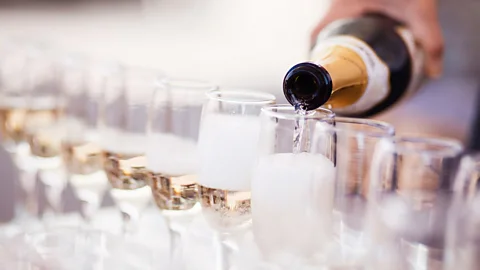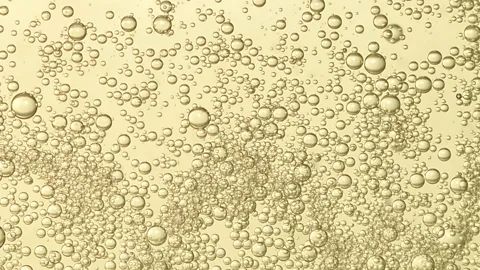The chemistry that gives champagne its famous fizz
 Getty Images
Getty ImagesHow does champagne produce its fizz – without breaking the bottle? Some fiendishly clever fermenting techniques and a big dose of chemistry, it turns out.
The glittering bubbles of a glass of champagne are part of life’s rituals, from wedding toasts to Sunday brunch. They come from a rather counter-intuitive process, however, and a clever chemical sleight of hand keeps the gas in even as winemakers open the bottles part-way through.
If you visit the Champagne region, you might be surprised to hear a champagne maker discuss adding a slurry of sugar and yeast to their wine. To the novice, it sounds like what you do at Christmas with a really bad red wine: dump in sugar, a bit of water, spices, get it on the boil, maybe add some kirsch – thus transforming cheap plonk into a mulled seasonal treat.
But the careful addition of sugar and yeast to a white wine is a central part of making any champagne. As the microorganisms digest the sugar, they release carbon dioxide that dissolves in the wine around them. They are the source of those characteristic bubbles.
You might also like:
“There is a direct correlation between the number and size of the bubbles and the amount of the sugar,” says Gerard Liger-Belair, a physicist at the University of Reims who studies the bubbles in champagne. The more sugar, the larger the bubbles and the more of them, as boosting the amount of energy available to the yeast means they release more gas.
Strictly speaking, there aren’t actually bubbles in the wine until you open it, reducing the pressure and allowing the gas molecules to come together suddenly out of solution – more bubbles form as the champagne makes with imperfections and speckles of dust on the interior of a champagne glass.
 Getty Images
Getty ImagesThe yeast in the wine has of course long since died by the time it’s decanted into a glass. But the tiny bodies have also been removed, because a champagne bottle does not stay inviolate between the addition of yeast and its arrival with the customer.
To get the sludge of yeast corpses, called lees, out of the wine, champagne makers tip the bottles upside down and store them in angled racks, going through every now and then to gently rotate the bottles. The lees end up down in the bottle’s neck, settled together in a silty mass. (These traditional wooden racks are called pupitres; eventually it became possible to purchase a device charmingly named the Pupi-Matic that would turn the bottles itself.)
What happens next is a brilliant bit of applied chemistry said to have been invented in 1884. The necks of the bottles are dipped in a very cold saltwater bath – colder, in fact, than 0C (32F). It’s still liquid, because the salt lowers the freezing temperature of the solution, but it manages to solidify the mush in the neck of the bottle.
Then, with the cap removed, the pressure of the gas in the wine pushes the yeast-ice-cube out.
The bubble conundrum
The link between bubble size and quality
Does the size of the bubbles in a bottle of fizz bear any relation to the wine’s quality?
It was long thought that smaller bubbles might not be the best vehicle for releasing aromas – a vital part of flavour – but recent research suggests larger bubbles might be more common in cheaper varieties.
According to physicist and lecturer Helen Czerski, listening to the pop of the bubbles as they hit the surface might be a clue to their size – with the smaller bubbles having a higher pitch.
 Getty Images
Getty ImagesIt might surprise you to learn that among the reactions that take place afterwards is the Maillard reaction, which also occurs when bread toasts, bacon fries, and onions caramelise. “In champagne, the Maillard reaction creates biscuity, brioche-like flavours over a long period of post-disgorgement ageing,” writes Peter Liem in his authoritative 2017 book, Champagne. This reaction between proteins and sugars and others can produce intriguingly complex tastes, and Liem posits that most champagnes benefit from a year’s worth of aging after having the lees removed, though they are usually released for sale at that time.
Liger-Belair is presently investigating how long it’s possible to age a champagne without risking the loss of the bubbles. The best champagnes can age for several decades, but the cork is not actually hermetically sealed, so the longer you wait, the higher risk of a flat wine. “We work a lot with mathematical models” of the cork and the dynamic environment inside the bottle, he says.
When the champagne is ready to be opened, a gentle twisting motion on the bottle to loosen the cork will help keep its fizz in the wine and not in your lap. In a single bottle of champagne are five litres of carbon dioxide, Liger-Belair estimates. When you next open a bottle and enjoy the storm of bubbles, think of the delicate mix of biology and chemistry that brought them to life.
--
If you liked this story, sign up for the weekly bbc.com features newsletter, called “If You Only Read 6 Things This Week”. A handpicked selection of stories from BBC Future, Culture, Capital, and Travel, delivered to your inbox every Friday.
